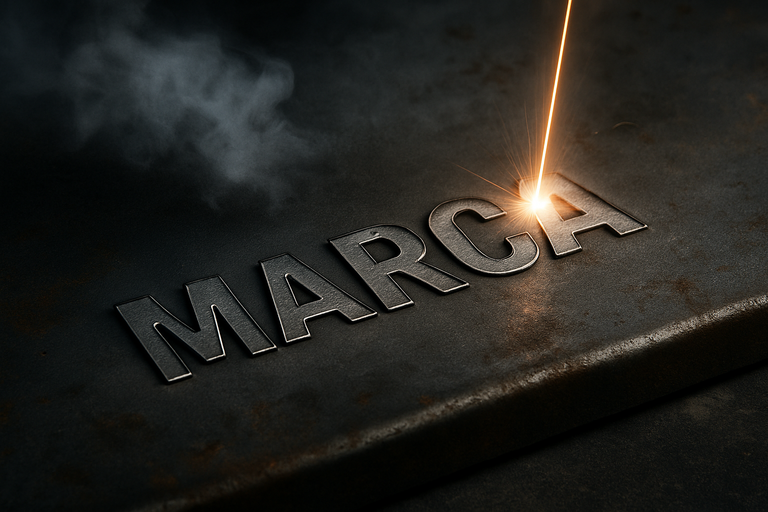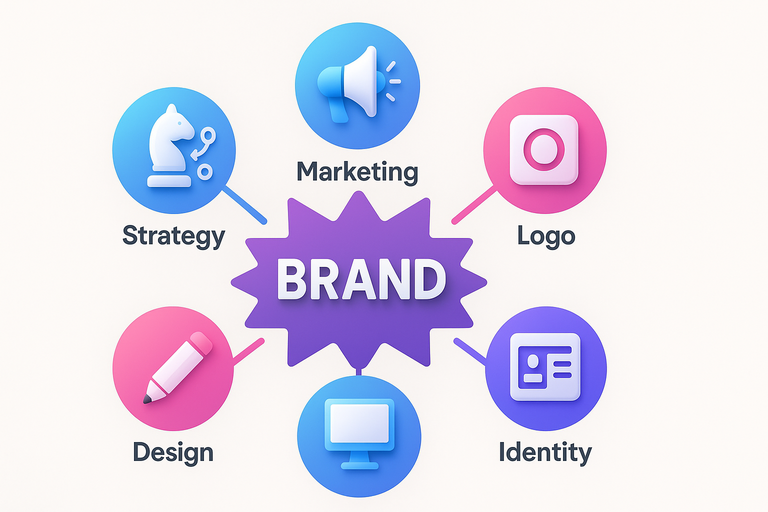 Imagen de mi autoría generada con ChaGPT
Imagen de mi autoría generada con ChaGPTEsto es algo que debo decir sin darle muchas vueltas al asunto.
Hoy en día no es suficiente tener un loguito bonito y una página web decente, si realmente quieres que la gente te tome en serio, necesitas construir una identidad digital coherente, sí, eso suena rimbombante, pero la verdad es que no es tan complicado como parece.
Déjame contarte cómo lo he visto y vivido yo.
Cuando uno empieza, suele pensar, Ok abriré mi cuenta en Instagram, le pongo mi nombre, subo un par de fotos bien lindas y, listo, estoy ready.
Ahí está el primer ¡gran error!... La verdadera construcción comienza cuando decides quién eres como marca y qué quieres que el mundo perciba de ti.
Si realmente quieres que te tomen en serio, y que la gente te identifique, confíe y eventualmente consuma tu producto o servicio, tienes que trabajar estratégicamente tu marca desde cero.
¿Y cómo es eso?
Te lo voy a resumir en los cinco grandes bloques que aplico cuando trabajo sobre la identidad digital, tanto para marcas personales como para negocios.
1• Propósito. Este es el corazón de tu marca
Si no tienes claro por qué haces lo que haces, todo lo demás es decorativo, es humo. Tu propósito, lo que en marketing llamamos brand purpose, es la razón de ser de tu marca.
¿Qué problema resuelves?
¿Qué valor aportas?
¿Por qué debería importarle a alguien lo que haces?
Cuando tu propósito está claro, todo lo demás fluye. Cada post, cada video, cada email, cada historia que cuentes, tienen que respirar ese propósito. Es lo que hace que tu marca sea más que un logo, la convierte en un proyecto con alma.
2 • Propuesta de valor y diferenciación.
Después viene la gran pregunta… ¿por qué alguien debería elegirte a ti y no al resto?
Aquí entra la propuesta de valor, es esa frase, explícita o implícita, que le responde al cliente potencial: “Conmigo vas a obtener esto, de esta manera, que es mejor o diferente al resto por esta razón.”
Puede ser que seas el más rápido, el más especializado, el más accesible, el que entiende mejor a un nicho específico. No importa cuál sea tu diferenciador, pero tienes que tenerlo claro y comunicarlo siempre.
3 • Tono de voz. ¿Cómo suenas?
Aquí es donde tu marca empieza a ser reconocible incluso sin ver tu logo. El tono de voz es la personalidad verbal de tu marca.
¿Eres cercano? ¿Profesional? ¿Sarcástico? ¿Inspirador? ¿Didáctico?
Por ejemplo, yo aquí te hablo como si estuviéramos tomando un café, eso no es casual, es una elección estratégica de tono, porque quiero que me reconozcas como tu amigo, ese que te apoya y te ayuda a llevar tu emprendimiento o marca al siguiente nivel. Y ese tono se debe mantener siempre igual, así estés escribiendo un post, respondiendo un email o grabando un video.
4 • Identidad visual. Este es el envoltorio coherente.
Sí, aquí es donde entran el logo, los colores, las tipografías, las imágenes, los diseños. Pero… ¡OJO! no es simplemente que se vea bonito. La identidad visual es el sistema gráfico que codifica tu marca visualmente. Te hace reconocible al instante.
Si vendes consultoría financiera seria, tu imagen debe reflejar profesionalismo y confianza. Si vendes productos para jóvenes, tu visual debe ser más fresca, colorida y dinámica.
Lo importante es que todo lo visual esté alineado con tu propósito y con tu tono.
Y por último, pero la más importante…
5 • Consistencia y posicionamiento.
Esta es la palabra mágica, Consistencia, si lo se, es aburrida, pero es la clave del éxito.
Ser consistente significa que todo lo que hagas, en cualquier canal, Instagram, LinkedIn, tu web, tus correos, Hive, sea y parezca ser parte de la misma historia.
Esa repetición coherente es lo que va construyendo tu posicionamiento en la mente de la audiencia, con el tiempo, la gente no solo te va a reconocer, sino que empezará a asociarte con un tema, una solución o un estilo, allí es cuando tu marca empieza a ser realmente fuerte.
 Imagen de mi autoría generada con ChaGPT
Imagen de mi autoría generada con ChaGPTPersonalmente me gusta usar esta analogía para explicar brevemente el proceso: Construir tu identidad digital es como conocer a alguien, primero te van a ver, luego te van a reconocer, después te van a identificar con algo específico y si haces bien el trabajo, terminarás siendo referencia en ese tema.
Y para eso no necesitas tener todo perfecto desde el primer día, solo debes trabajar cada bloque con intención y tu marca irá tomando forma, si lo haces te aseguro que con el tiempo atraerás a la audiencia correcta.
Ahora bien, para que esto no quede solo en teoría, déjame darte un par de ejemplos muy simples, que puedes utilizar como plantilla para crear la base de tu Identidad Digital :
Ejemplo 1 👉 Marca personal de asesoría financiera para millennials.
Propósito: Enseñar a jóvenes a tomar buenas decisiones financieras desde temprano.
Propuesta de valor: Explicaciones claras, sin jerga técnica, con herramientas prácticas.
Tono de voz: Cercano, didáctico, directo, con humor ocasional.
Identidad visual: Colores suaves, tipografías modernas, imágenes frescas.
Consistencia: Todos los videos, posts, guías descargables y webinars siguen el mismo estilo educativo desenfadado.
Resultado: En menos de un año, la audiencia comienza a reconocerlo como "el amigo que te explica las finanzas sin complicarte la vida".
Ejemplo 2 👉 Tienda online de productos artesanales sustentables.
Propósito: Ofrecer productos hechos a mano, cuidando el medio ambiente y apoyando a productores locales.
Propuesta de valor: Productos únicos, ecológicos y éticos.
Tono de voz: Inspirador, emotivo, con storytelling de impacto social.
Identidad visual: Paleta tierra, fotografías naturales, diseño minimalista.
Consistencia: Cada publicación cuenta pequeñas historias de los artesanos, de los materiales reciclados, del impacto social detrás de cada compra.
Resultado: El público conecta emocionalmente y se fideliza no solo por el producto, sino por los valores de la marca.
¿Ves? Al final, la identidad digital no es un tema de grandes presupuestos ni de suerte, es un trabajo de claridad, intención y ejecución sostenida.
Empieza simple, pero empieza con estrategia, todo lo demás será solo consecuencia ;)

🇬🇧 English Version
 Image of my own, generated with ChaGPT
Image of my own, generated with ChaGPTThis is something I have to say without beating around the bush. Nowadays, it's not enough to have a nice logo and a decent website. If you really want people to take you seriously, you need to build a coherent digital identity. Yes, that sounds pretentious, but the truth is, it's not as complicated as it seems. Let me tell you how I've seen and experienced it. When you start out, you usually think, "Okay, I'll open my Instagram account, add my name, upload a couple of nice photos, and that's it, I'm ready." That's the first big mistake!... The real construction begins when you decide who you are as a brand and what you want the world to perceive about you. If you really want to be taken seriously, and for people to identify with you, trust you, and eventually consume your product or service, you have to strategically develop your brand from the ground up. And how does that work? I'll summarize it in the five main building blocks I apply when working on digital identity, both for personal and business brands. If you're not clear about why you do what you do, everything else is window dressing, it's just smoke and mirrors. Your purpose, what we call brand purpose in marketing, is your brand's reason for being. What problem do you solve? What value do you provide? Why should anyone care about what you do? When your purpose is clear, everything else flows. Every post, every video, every email, every story you tell must reflect that purpose. It's what makes your brand more than just a logo; it turns it into a project with soul. Then comes the big question... why should someone choose you and not the rest? This is where the value proposition comes in. It's that phrase, explicit or implicit, that tells the potential client: "With me, you'll get this, in this way, which is better or different than the rest for this reason." You may be the fastest, the most specialized, the most accessible, the one who best understands a specific niche. It doesn't matter what your differentiator is, but you have to be clear about it and always communicate it. This is where your brand begins to be recognizable even without seeing your logo. Your tone of voice is your brand's verbal personality. Are you approachable? Professional? Sarcastic? Inspiring? Educational? For example, I'm speaking to you here as if we were having coffee. That's not a coincidence; it's a strategic choice of tone, because I want you to recognize me as your friend, the one who supports you and helps you take your business or brand to the next level. And that tone should always remain the same, whether you're writing a post, responding to an email, or recording a video. Yes, this is where the logo, colors, fonts, images, and designs come in. But... BE CAREFUL! It's not just about looking pretty. Visual identity is the graphic system that visually codifies your brand. It makes you instantly recognizable. If you sell serious financial consulting, your image should reflect professionalism and confidence. If you sell products for young people, your visuals should be fresher, more colorful, and dynamic. The important thing is that everything visual is aligned with your purpose and tone. And last but not least... This is the magic word, Consistency. Yes, I know, it's boring, but it's the key to success. Being consistent means that everything you do, on any channel—Instagram, LinkedIn, your website, your emails, Hive—is and appears to be part of the same story. This consistent repetition is what builds your positioning in your audience's mind. Over time, people will not only recognize you, but will begin to associate you with a theme, a solution, or a style—that's when your brand really starts to grow. Personally, I like to use this analogy to briefly explain the process: Building your digital identity is like getting to know someone. First, they'll see you, then they'll recognize you, then they'll identify you with something specific, and if you do your job well, you'll end up becoming a reference in that field. And to do that, you don't need to have everything perfect from day one. You just have to work on each block with intention, and your brand will take shape. If you do, I assure you that over time, you'll attract the right audience. Now, so this isn't just theoretical, let me give you a couple of very simple examples that you can use as a template to create the foundation of your Digital Identity: See? In the end, digital identity isn't a matter of big budgets or luck; it's a work of clarity, intention, and sustained execution. Start simple, but start with strategy, everything else will be a consequence ;)
1• Purpose. This is the heart of your brand
2 • Value proposition and differentiation.
3 • Tone of voice. How do you sound?
4 • Visual identity. This is the coherent packaging.
5 • Consistency and positioning.
 Image of my own, generated with ChaGPT
Image of my own, generated with ChaGPT
Example 1 👉 Personal brand for financial advice for millennials.
Example 2 👉 Online store for sustainable artisan products.
